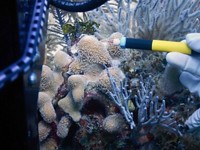Advertisement
Grab your lab coat. Let's get started
Welcome!
Welcome!
Create an account below to get 6 C&EN articles per month, receive newsletters and more - all free.
It seems this is your first time logging in online. Please enter the following information to continue.
As an ACS member you automatically get access to this site. All we need is few more details to create your reading experience.
Not you? Sign in with a different account.
Not you? Sign in with a different account.
ERROR 1
ERROR 1
ERROR 2
ERROR 2
ERROR 2
ERROR 2
ERROR 2
Password and Confirm password must match.
If you have an ACS member number, please enter it here so we can link this account to your membership. (optional)
ERROR 2
ACS values your privacy. By submitting your information, you are gaining access to C&EN and subscribing to our weekly newsletter. We use the information you provide to make your reading experience better, and we will never sell your data to third party members.
Environment
Superoxide's Swelling Significance
Underwater life may be using the oxygen radical to make essential nutrient more available
by Sarah Everts
March 27, 2007

Superoxide may not be top of mind as a major underwater electron source, but this reducing agent may play a larger role in ocean energetics than was previously thought, according to new research presented at the American Chemical Society national meeting in Chicago.
With just one extra electron, superoxide is an important intermediate in the conversion of dioxygen to peroxide, which is a major player in ocean redox chemistry, commented William J. Cooper, an ocean chemist at the University of California, Irvine.
Now, new direct measurements of sea superoxide concentrations at 18 locations in the Pacific Ocean near Australia and Central and South America suggest that existing superoxide levels far exceed previous estimates—sometimes by as much as an order of magnitude, said Andrew Rose, a postdoc at both Woods Hole Oceanographic Institution and the University of New South Wales in Sydney, Australia, who presented his findings before the Division of Geochemistry.
"It's exciting to find that superoxide has a lifetime on the order of minutes such that it can build up to a concentration significant enough to potentially play a role in the ocean's metal redox chemistry," says Bettina Voelker, an ocean chemist at Colorado School of Mines.
Furthermore, Rose found the superoxide at depths far beyond light's penetration, which challenges the existing wisdom that photooxidation is the primary source of superoxide in the sea. Microorganisms may be producing the missing quantities of superoxide to "cope with life in a highly oxidized environment," Rose told C&EN.
For example, most underwater microbes need iron for their metabolism but cannot readily absorb the organically complexed Fe3+ dominant in the ocean. Rose argued that these organisms make superoxide in order to reduce nearby iron to more readily absorbable Fe2+, which they can then use.
"Iron has been shown to be a limiting nutrient for microorganisms and phytoplankton," Rose explained. "These organisms are deliberately producing superoxide in their environment by passing electrons produced in metabolism across the membrane." This energetic expenditure pays off by reducing metals into a more biologically useful state, he added.
Superoxide may also be important in the cycling of ocean copper, manganese, and chromium, Cooper said.
Rose measured the levels of superoxide, using a chemilumniscence reagent called methyl Cypridina luciferin analog that glows at an intensity proportional to superoxide concentration. He checked not only the absolute concentration of superoxide at different ocean locations but also the ability of cyanobacteria, diatoms, and algae to produce it. Next up, Rose will test a greater diversity of creatures for their ability to make superoxide.
This "incredibly sensitive" chemiluminescence method, Voelker says, will also help the broader research community figure out the relative contributions of photochemical and "dark" sources for superoxide production in the sea.




Join the conversation
Contact the reporter
Submit a Letter to the Editor for publication
Engage with us on Twitter